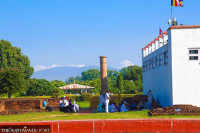Lumbini Province
Banke National Park launches gharial conservation drive
Plenty of fish and low pollution in the Rapti river makes it a perfect habitat for gharials.
J Pandey
The Banke National Park has begun what it called “serious” conservation efforts for gharials in the Rapti river, Banke. Gharial is a critically endangered crocodile species found primarily in Nepal and India.
A team of experts from the United Kingdom had conducted a study on the ecosystem of the Rapti river three months ago. Their report suggested the water in the river is a suitable habitat for gharials from an environmental point of view. Based on that report, the National Trust for Nature Conservation has extended its support to the Banke National Park in the conservation efforts of gharials.
Earlier, Bardiya National Park’s Crocodile Breeding Centre handed over 10 gharials—two males and eight females—that were brought from the Chitwan National Park to the Banke National Park. They were released in the Baskholi area of the Rapti River, Banke, on February 2, coinciding with World Wetlands Day.
According to Shyam Kumar Shah, head of the Banke National Park, gharials are only found in freshwater rivers where human encroachment is low and the number of fish is high.
“The pollution level in the Rapti River is low which makes it a good place for the gharials since the species sustains on freshwater fish,” said Ashok Kumar Bhandari, head of the Bardiya National Park.
“In order to build a comfortable environment for gharials, fishing has to be controlled in the Rapti River,” he added.
However, restricting fishing in the river stands to jeopardise the local Khunar and Kumal communities who depend on fishing for their livelihood.
“If we restrict fishing in the river, the number of gharials is expected to rise, but such a ban would put the livelihoods of the local communities at risk,” said Shah. “We are currently looking for ways that will allow us to ensure food for both the endangered species and the local communities.”
According to Shah, they have given fishing licences to individuals from the two above-mentioned communities, with some restrictions. While fishing the locals have been barred from using fishing nets and they can only use fishing rods. “Fishing nets are dangerous for gharials because they get entangled in the net and get injured or die,” said Shah. “We are also planning to teach the fishermen about fish farming in ponds so that they will be able to earn money without having to fish in the river.”
Bhandari, head of the Bardiya National Park, says there are about 250 gharials in Nepal. Among the two species of crocodiles that are found in Nepal (the other being mugger crocodile), gharials are calm and not aggressive towards humans.
“The gharials prefer fish over any aquatic or land animals. Their primary threats include habitat loss due to human encroachment, unsustainable fishing practices, and hunting. Since 1970, the species has come alarmingly close to extinction. Gharial was once found in Pakistan and Myanmar, but it is now only found in Nepal and India, so it is critical to work on its conservation,” said Bhandari.
According to the law, anyone found guilty of killing or hunting the endangered gharial faces a fine of Rs100,000 to Rs500,000 or imprisonment of one to ten years, or both.
The Banke National Park, considered the youngest national park in Nepal, has made a marked contribution in the conservation of the rare royal Bengal tiger and is now campaigning to increase the number of aquatic animals, including gharials at the park.




 13.12°C Kathmandu
13.12°C Kathmandu










